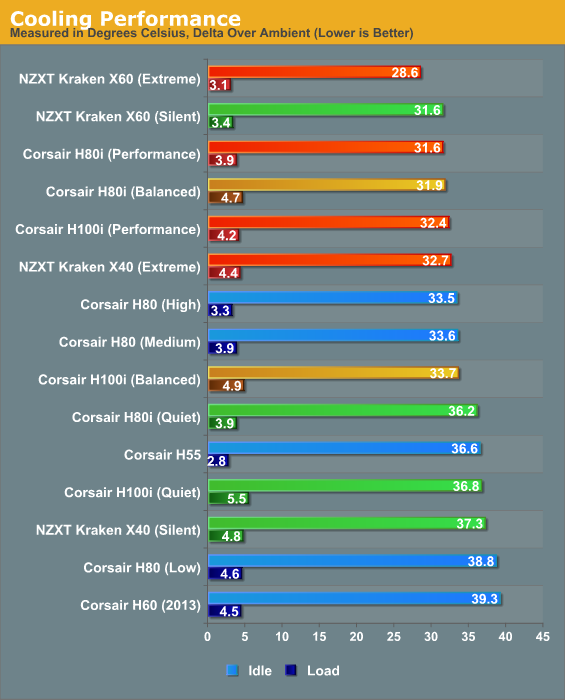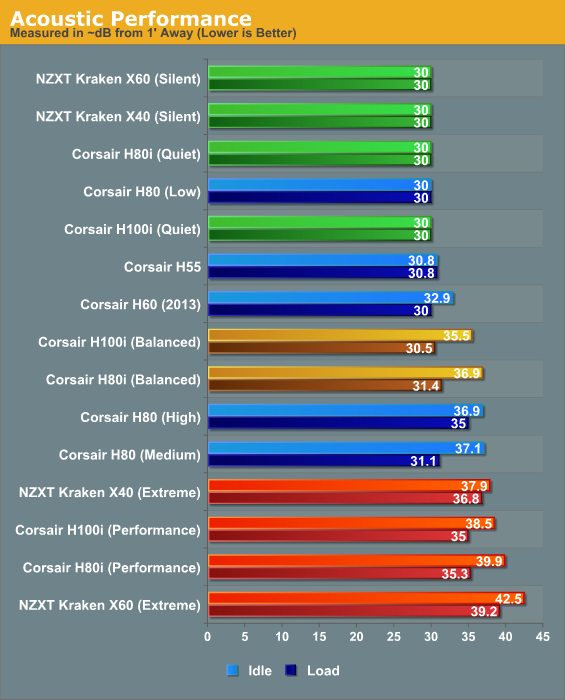Closing the Loop: Contained Liquid-Coolers from Corsair and NZXT Compared
by Dustin Sklavos on December 26, 2012 12:01 AM ESTPerformance Results
Going into testing, it's pretty easy to expect how the coolers should ultimately stack up: Corsair's H55 should be last, followed by the H60, the H80, the H80i, the NZXT Kraken X40, the H100i, and then the NZXT Kraken X60 at the top of the list. The X40 and H80i should compete pretty closely; the X40 has a larger surface, but the H80i has a thicker radiator and a second fan. Corsair's also been happy to advertise that these "2013" radiator fans are based on their successful SP120 radiator fans, which makes sense. We found the Silent SP120 to be pretty solid while the Performance model was at the top of its game if noise was a non-issue.
Keep in mind, though, NZXT's stock radiator fan did surprisingly well in our testing too.
So how did these systems turn out?

Surprisingly, two early favorites turn out to be major underperformers: the Corsair H100i for some odd reason is consistently worse than the H80i (and I did retest to confirm), while the Kraken X40 needs to run at full bore to produce decent results. Meanwhile, the H55 with its constant fan speed actually manages to best the new H60 (though PWM control may certainly contribute to that).
So where are the big winners? While the H80i is pricy, it does perform notably better than its predecessor, producing better thermals at a lower setting. And the most expensive system of all at least earns its price tag; the NZXT Kraken X60 turns out to be every bit the cooling monster the rep promised it would be, meeting or beating every other cooler at its lowest setting.

As far as noise is concerned, the X60 is once again at the top of the pack. Note that our sound meter doesn't go below 30dB and the X60 is noticeably louder than the X40, but not by much and not enough to really change the way things turn out.
So how do noise profiles change the standings? The X60 excels in both disciplines and is essentially undefeated, but the Corsair H55 makes a good case for itself. Thermal performance isn't fantastic, but it's quieter than the H60 under load while running cooler. Meanwhile the H80i remains basically the best offering in Corsair's lineup, running slightly cooler and quieter than the single-fan Kraken X40.










68 Comments
View All Comments
A5 - Thursday, December 27, 2012 - link
If you care about that stuff, you aren't going to buy a closed loop system.Novuake - Thursday, December 27, 2012 - link
That is why I would like REAL data to compare with other cooling solutions... Otherwise whats the point of a comparison if I do not know how CLCs compare to a custom loop.jabber - Thursday, December 27, 2012 - link
....I installed it as Corsair directed as an intake and it's still installed that way. However, I was concerned that as the PSU (Corsair HX750) was sat above it and blowing out warm air that we would end up with a cycling of warm air back into the case which wouldn't help.I noticed that as my PC desk had a closed back that the air space behind the PC got warm. Warm air from the PSU was being drawn down so cool air wouldnt be going into the H50.
So I devised a simple solution of sticking a simple air dam about 3 inches deep along the full width and back of the case just below the PSU. The dam was angled at 45 degrees therefore, 'pushing' the warm air up and over and closing the space between the back of the desk and the PC.
This kept the air space below the PSU and right where the H50 intake was nice and cool.
Treckin - Thursday, December 27, 2012 - link
Would be nice if you at least mentioned the Antec pieces which were even a little ahead of the Corsair pieces (Until the recent "i" series) .Kulher 920?
A5 - Thursday, December 27, 2012 - link
Not a 2013 model. The H80 is only here to provide reference to the most popular 2012 model, the rest is new for 2013.monsooni - Thursday, December 27, 2012 - link
I have been thinking about my case layout and air flow. I am using a Corsair 650D with the original H50 cooler. Since most "gamer" class video cards come close to closing off the air flow between the bottom of the case and the upper areas, it is possible that rotating the rear exhaust fan to become an intake, and using the top fan as the exhaust for the upper area, makes sense if you have a setup that closes off the bottom.That type of setup would give the case "zones" that could be managed for noise and temp separately of each other, similar to rack mount servers.
Shiitaki - Thursday, December 27, 2012 - link
In reading some of the comments, I had some thoughts on water cooling. This review is a comparative review, useful if you are deciding between the reviewed units. It also indicates trends, and gives an idea of the benefit to the big radiators. With enough are flow, you won't need a big radiator, using a big radiator really lowers the required fan noise, not just cooling. Indeed, a modern processor doesn't NEED a big radiator. Water is good for cooling, you may have noticed that even Porsche uses water now. Water carries ten times the heat. I switched from air to water and lowered the temp by 8c not because the water cooler was getting rid of more heat, but because the heat was being carried away faster with water running through the water block than being carried up copper pipes. When it comes to cases, who cares? Unless the testing happens to be done in the case you have or will have, does it really matter? I agree with the critique that some details about the pumps would have been good. Water cooling can make for a very quite computer, unless there is pump noise and gurgling going on. The inability of the sound pressure meter to go below 30 db is also not great. I can assure you that Apple's sound meter goes lower, having spent some considerable time trying to match the silence of an iMac. A great review to see, I went with Zalman just prior to the review though. It has what I think is a goofy Asetek mounting and has some pump rattle. The rattle is quietter after a couple of days. When it comes to cases, their is little novelty or innovation. The Raven series is the rare diversion in the industry.When I did a full fledged water cooling setup, cooling the video card was a huge difference, much more so than the cpu. Water cooling is what Nvidia should be using for their high end cards. There's an idea for Zalman, a closed loop system with a universal mounting for video cards.
dusk007 - Thursday, December 27, 2012 - link
Why a water cooling solution just for the CPU. They are big and expensive and CPUs are in almost any case (that you can fit one of these) easy to cool. The only point I see for water cooling is when one has a workstation with two sockets or some GPUs to cool but such a single CPU closed All-In-One solution is useless there.Is there really a market for nerds who only want an overclocked CPU and don't care about nothing else. A Gamer would want to cool the GPUs more as they matter and somebody that needs number crunching power will get more out of a two socket workstation than overclocking.
Why aren't there any decent tests of Sets for actual water cooling that can incorporate 1-2 GPUs and not only the CPU which has more than enough space for a huge tower cooler anyway (and those work fine)?
Treckin - Thursday, December 27, 2012 - link
The Antec closed loop systems had the integrated USB interface far before Corsair, Im not sure why they arn't mentioned here. Also, I believe they are made by Asetek and judging by the look of the software in the NZXT, it looks like a bad reskinNot very thourough if you ask me
darkfalz - Thursday, December 27, 2012 - link
Would have been a good inclusion for comparison...